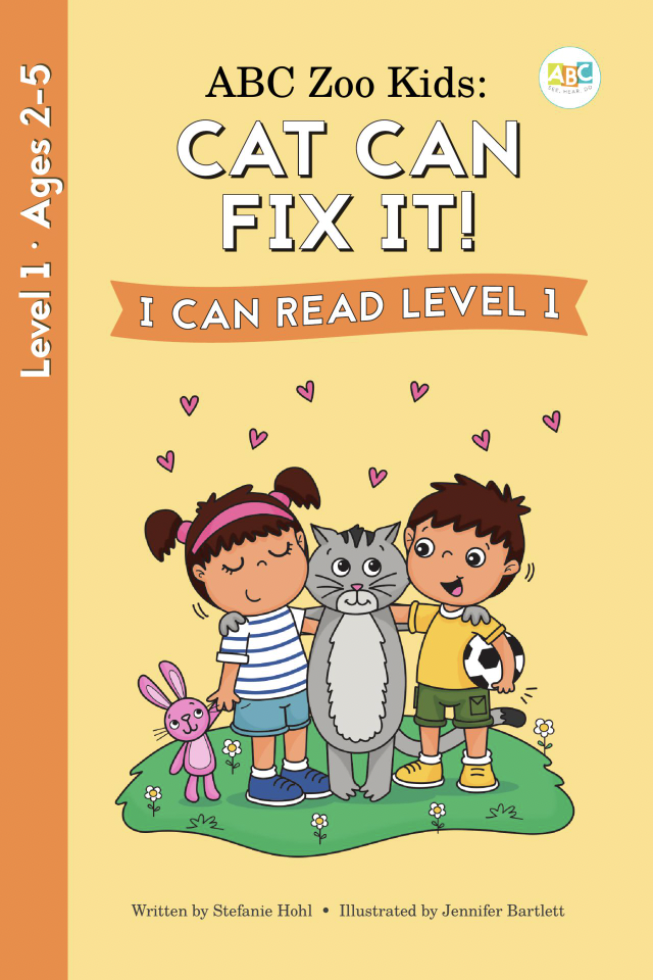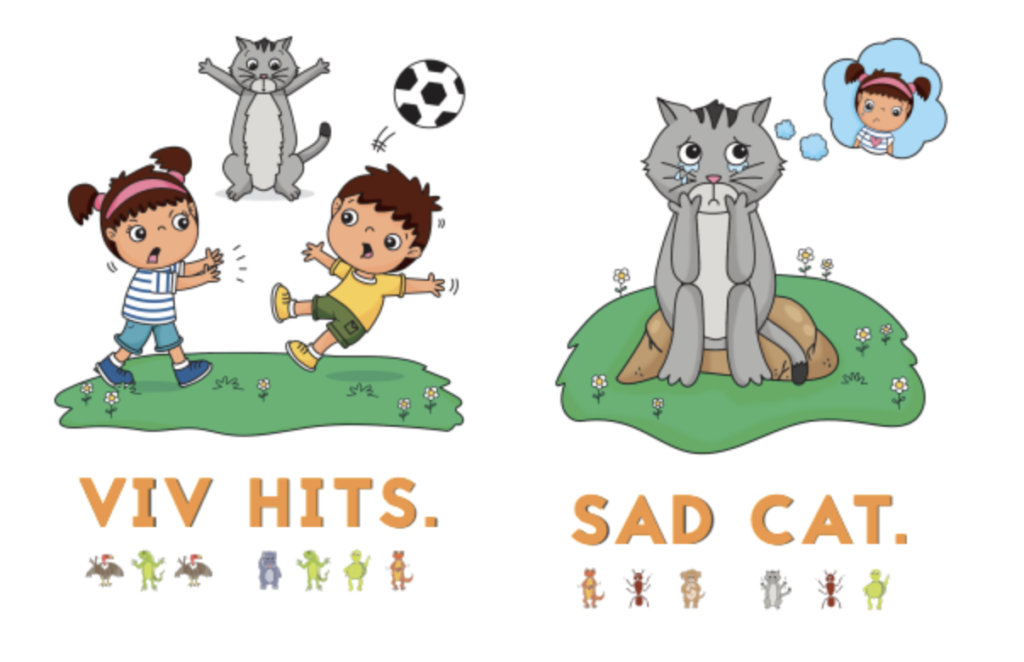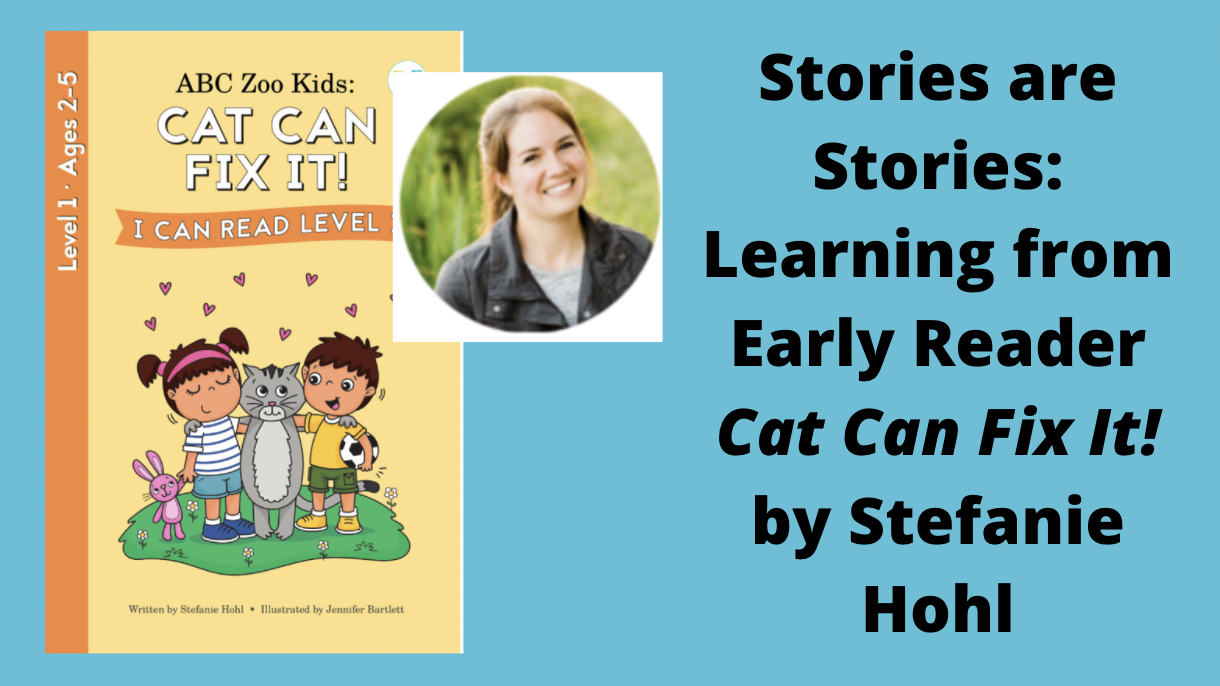craft post by Anne-Marie Strohman
In our interview with Stefanie Hohl, she talked about how she works to tell a satisfying story for early readers:
In my early reader, Cat Can Fix It, I wanted to write a complete story with a character arc, emotional depth, and an interesting plot. But I could only use CVC (consonant vowel consonant) words, such as cat, sat, or pat. I couldn’t use “I” or “me” or “the” or “said,” because young children can’t sound those words out. It took a lot of thought and creativity to figure out how to accomplish this. (Read the whole interview here.)
Just because you have to use simple words doesn’t mean the story has to lack emotion or depth. It’s challenging, but early readers can still use all the elements of story—character, plot, setting, etc. In fact, looking to early readers as a model, writers in other categories can see how efficient storytelling can be without sacrificing emotional depth.
Cat Can Fix It!
Here’s some of the text of Cat Can Fix It! an I Can Read Level 1 book in the ABC, See, Hear, Do series, with summaries of the missing sections in italics. The whole text is 44 words total, with only 16 unique words. (I’ve added art notes in brackets.) (You can purchase the whole book here or to read on Kindle here.)
Viv.
Gus.
Cat.
Gus taps. [knees a soccer ball]
Viv tugs. [grabs soccer ball from Gus]
Viv hits. [bonks Gus with soccer ball]
Mud! [Gus falls in the mud]
Sad Gus.
[Mom gives Viv a timeout. Then Cat tugs on Viv’s bunny and swats at her. Viv gives Cat a timeout.]
Cat sits.
. . . [Cat thinks]
Sad Cat.
Fix it! [Cat has an idea!]
Rub, Rub. [Cat rubs against Viv’s legs]
Hug. [Viv hugs Cat.]
. . . [Viv thinks, remembers Sad Gus]
[Viv thinks back to how sad Gus was and decides she can fix it too! She washes Gus’s soccer ball and returns it to him.]
Hugs! [Gus, Viv, and Cat hug]
So few words and so much story!

The Role of Illustrations
Because creating an early reader allows the author only limited word choice, the illustrations serve to not enhance the story in the text, but to clarify and extend it. You can see in the bracketed illustration notes how much the pictures do the work. For instance, “Rub, rub” on its own, could mean any number of things, but because of the illustrations we know that in the first instance Cat is rubbing against Viv’s legs, and in the second instance Viv is rubbing the soccer ball.
Picture book authors are often told to leave room for illustrations. We can tell the story fully through text, but looking at early readers, where the word choice and word count are so limited, can open up possibilities for how to use illustrations in picture books, too.
Repetition
In an early reader, repeating individual words helps a new reader develop fluency, as the second, third, and fourth time they see a word, the easier it will be for them to decode. It also creates a comforting rhythm and cadence for readers of all ages. Repeating short sentences has the same effect.
In addition to word and sentence repetition, Stefanie includes plot repetitions. Just like Viv was given a timeout for her actions, Viv gives Cat a timeout. And just like Cat fixed things with Viv, Viv can fix things with Gus. In both instances we can see how Viv is motivated to imitate the experiences she’s had.
For writers of any age category, incorporating meaningful repetition–at the word level, sentence level, or plot level–can enhance the reading experience, through familiarity and comfort, or through expectation and anticipation.
Emotional Change
The three main characters–Viv, Gus, and Cat–all go through meaningful emotional change. Gus is hurt and forgives Viv. Cat hurts Viv, feels remorse, and makes things right with Viv. Viv hurts Gus, is hurt by Cat, reconciles with Cat, feels remorse for her actions toward Gus, and makes things right with Gus. All in 44 words!
Including significant emotional arcs engages the reader more fully and creates a story with meaning and feeling, rather than a plot focused “See Jane run” sort of story.
Writers for all ages do well to consider the emotional arc of their characters. And the story becomes even richer if secondary characters have emotional arcs as well. Stefanie’s story can inspire you–if she can include three character arcs in 44 words, you can do it with more words too!

Resolution
The final image in Cat Can Fix It! is of the three characters we met at the beginning–Viv, Gus, and Cat–hugging. The three separate images of the characters at the beginning paired with the image at the end shows us the whole arc of the story. The characters go from being separate to coming together. That resolution is satisfying because it shows a change in the relationship, and who doesn’t love hugs?
As you consider your ending, whatever category you’re writing in, compare it to your opening. Do the two contrast each other in a way that reveals the story? Does the ending resolve in a way that’s satisfying? Characters coming together is satisfying, but anything that can confirm how the main character has changed can also be satisfying.
Stories are Stories
Stefanie’s early reader shows us that stories are stories are stories. Just because a story is told in 44 consonant-vowel-consonant words doesn’t mean the story requirements change. The story can still have emotional change for more than one character and a satisfying ending that leaves readers wanting to read the story again.
Now it’s YOUR turn!
- If you’re writing a picture book, look at how early readers use illustrations to communicate story and see if you can cut some words to let the illustrations do the work for you.
- Look for opportunities for repetition, at the word level, sentence level, and/or plot level.
- Examine your main character’s emotional change. Then look at secondary characters. Are there ways you can enhance the changes?
- Focus on the opening and closing images of your story. What do they tell you about the story itself? Can they be tweaked or changed to more clearly communicate the themes of the story?
- Look at your final resolution. Does it confirm the character’s emotional change?
On Character Arcs:
On Repetition:
On Endings:
Anne-Marie Strohman (co-editor) writes picture books, middle grade novels, and young adult short stories and novels. She is trained as a teacher, an editor, and a scholar, specializing in Renaissance Literature. She holds an MFA in Writing for Children and Young Adults from Vermont College of Fine Arts and is an active member of SCBWI. Find her at amstrohman.com and on Twitter @amstrwriter.

COMMENTs:
0